Widgetized Section
Go to Admin » Appearance » Widgets » and move Gabfire Widget: Social into that MastheadOverlay zone
The Tale of Two Sarahs
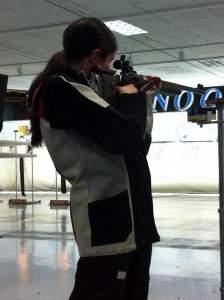 Sarah Irish has to concentrate. Focus on standing still. Shooting slow while controlling her breathing, her sights and of course her trigger.
Sarah Irish has to concentrate. Focus on standing still. Shooting slow while controlling her breathing, her sights and of course her trigger.
All this while facing off against the famed University of Alaska-Fairbanks on their home range.
The 18-year-old freshman is a new member of the Rose-Hulman Institute of Technology NCAA Rifle Team. And in NCAA rifle competition control is everything – especially going up against the fifth ranked team in the nation.
But while Sarah may be new to NCAA smallbore (and air rifle), the pressure of competition is nothing new to her. You see, Sarah’s kinda like Superman with a dual, secret identity.
At school she’s a normal coed, surrounded by students her own age, living in the dorms, balancing a collegiate social life against the rigors of a chemical engineering major.
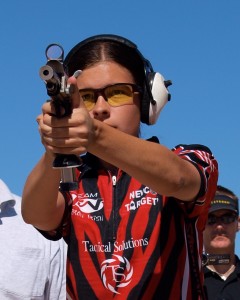 But, outside of school on ranges across the country, she dons her other competition gear, her lightweight shooting shirt, her custom-built, high-speed blaster, and miraculously she turns into Sarah Irish top-ranked women’s Master in USPSA’s practical shooting.
But, outside of school on ranges across the country, she dons her other competition gear, her lightweight shooting shirt, her custom-built, high-speed blaster, and miraculously she turns into Sarah Irish top-ranked women’s Master in USPSA’s practical shooting.
In USPSA competition speed, blazing speed, is a must. The guns are much smaller, the targets are much bigger, and they’re numerous. Then there’s the veritable who’s who of the world’s best women shooters all trying to out shoot Sarah on each and every pull of the trigger.
And here, up against the best, Sarah holds her own.
“Sarah is one of our youngest Master level shooters, and getting to that level is no easy feat. She’s proved herself to be a very strong competitor who belongs among the top tier of USPSA’s women shooters. I have no doubt that someday soon we won’t be talking about her being a Master, but a National Champion instead,” said Michael Voigt, USPSA president.
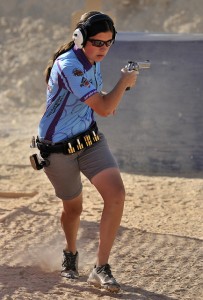 So how did the run-and-gun Sarah end up standing still with a rifle in her hands and calm in her mind and body?
So how did the run-and-gun Sarah end up standing still with a rifle in her hands and calm in her mind and body?
“I had heard about the team from a current student the summer before I moved to Rose-Hulman,” explained Irish. “I thought it would be an interesting experience, and I definitely want to try different types of shooting sports!”
Her appearance at the team’s open tryouts was a welcome sight for coach Jason LaBella who is used to having students show up who have never shot competitively.
“The first time I knew about her and her ability was during the first round of our open tryouts. I was excited because I like to have shooters on my team who are well rounded and have competition experience in a sport. Since hers was in a shooting sport, I was even more pleased,” said LaBella.
Sarah’s shooting skills were immediately evident to the coach, including her ability to learn how to perform a shooting skill. LaBella called it “very strong.”
She also brought the one skill every top USPSA shooter needs in their bag, the ability to call your shots.
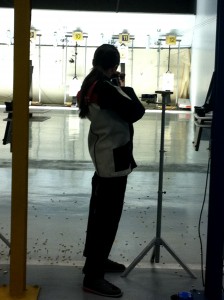 “I have been able to use my shot calling abilities from USPSA in rifle competition. When the 10-ring is a tiny dot, knowing you’ve called a good shot is extremely important,” said Irish.
“I have been able to use my shot calling abilities from USPSA in rifle competition. When the 10-ring is a tiny dot, knowing you’ve called a good shot is extremely important,” said Irish.
Of course coming from the high-speed world of USPSA also presented problems. The phrase “speed kills” was never truer than when in reference to smallbore competition.
LaBella admits that for Sarah the main problem is “the speed at which she shoots, and attention to events around the trigger execution such as follow through and clean trigger pull.”
He recognizes the transition can be tough noting that “when you go from shooting a plate to shooting a pinhead, every little flinch and imperfection is exposed.” But he also sees it as a valuable lesson that will help her shooting.
“Ultimately, I suspect that this will make her an even stronger pistol shooter,” observed LaBella. “The pistol world can accept my apologies now.”
Sarah agrees. “In USPSA competition, I have a tendency to shoot faster than I should. I’m hoping to use rifle shooting to help me slow down for a fraction of a second in USPSA to make sure I’m calling a good shot.”
Another major difference between the world of USPSA competition and NCAA Rifle is Sarah’s relationship to each group. In USPSA she’s often competing with women who are sometimes twice her age, or more. And at Rose-Hulman they are essentially the same age.
“It’s definitely a different experience being the same age as the rest of the competitors,” explains Irish. “It’s interesting to see the different skill levels that people in the same age group have. At USPSA competitions, I get a lot of attention for being a young female. However, in NCAA rifle, it’s quite common.”
What is uncommon though about her presence in NCAA shooting is that she’s likely the only member with YouTube videos posted of her in shooting competitions.
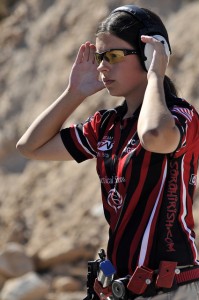 Despite downplaying her national ranking in practical shooting, much like Clark Kent hiding his secret identity, Sarah could not escape detection when she had to explain her absence from school.
Despite downplaying her national ranking in practical shooting, much like Clark Kent hiding his secret identity, Sarah could not escape detection when she had to explain her absence from school.
“I explained my involvement in USPSA early on in the season because I had to miss a few days of rifle practice to go to (USPSA) Nationals. I have showed them several videos of myself and others shooting and they were quite interested in it,” said Sarah.
“My teammates think USPSA shooting is awesome! I think several of them want to try pistol shooting and I’ll more than likely take them to a few local matches in the spring.”
Coach LaBella, the rifle world can accept USPSA’s apologies now.

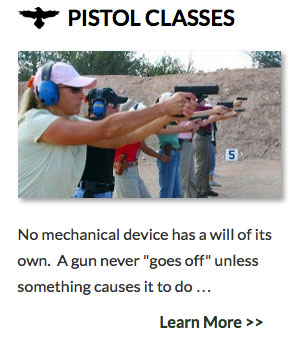

 MidwayUSA
MidwayUSA Ruger Firearms
Ruger Firearms SCCY Firearms
SCCY Firearms Streamlight
Streamlight Action Targets
Action Targets Gunsite Academy
Gunsite Academy
You must be logged in to post a comment Login